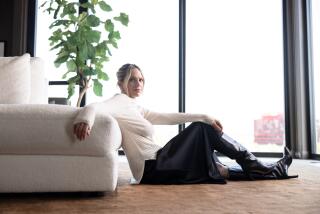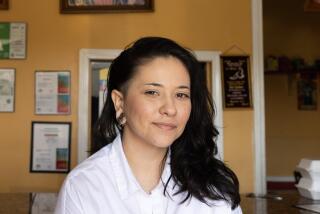She kept her ultra-Orthodox past secret. Now she’s using Netflix to tell her story

- Share via
New York — Julia Haart divides her life into two parts.
There are the 42 or so years she spent in an ultra-Orthodox Jewish community, playing the role of devout wife and mother — a chapter that was “all about what was done to me,” she says. Then there is the eight-year period “about what I’ve done,” including leaving behind her insular way of life, changing her name, launching a line of wearable high-heeled shoes, and rising to become chief executive of Elite World Group, a leading fashion talent agency.
The complete guide to home viewing
Get Screen Gab for everything about the TV shows and streaming movies everyone’s talking about.
You may occasionally receive promotional content from the Los Angeles Times.
“I’m like 50 and 8 at the same time,” says Haart, clutching a piping hot cup of Starbucks on a muggy morning in July. While most of us are reluctantly making the shift back into real clothes after 18 months in soft pants, Haart looks ready for the front row in a tweed Valentino skirt suit and towering black platform heels. All 5 feet ¼ inch of her are tucked into a plush chair in the lobby of the luxury Tribeca high-rise where she lives with her second husband, entrepreneur Silvio Scaglia Haart.
About an hour away is Monsey, N.Y., the suburban town where Haart once lived as a member of a Yeshivish Jewish group in which gender roles were rigidly circumscribed: Men were expected to study the Torah, and women were to raise large families and dress with extreme modesty. Access to the outside world, via television, the internet, radio and newspapers, was virtually prohibited.
Netflix’s “Unorthodox” recreates the customs of the Hasidic Jewish community in painstaking detail. We went behind the scenes to find out how they did it.
“We lived in the 1800s,” says Haart, who jokingly calls herself a time traveler.
Haart’s unlikely transformation from sheitel-wearing housewife to fashion big wig is the subject of “My Unorthodox Life.” The Netflix reality series, which debuted Wednesday, follows Haart and her four children — including a bisexual app developer and a Shabbat-keeping TikToker — as they attempt to forge their own personal, professional and spiritual paths.
It’s a story that she guarded closely for years and has not shared widely — until now.
“Until I felt that I had accomplished something, I didn’t want people to know about my past,” says Haart, who only started talking about her background once she’d been tapped as creative director of La Perla, the luxury lingerie line, in 2016, “because I didn’t want what was done to me to define me. I wanted what I had done to define me.”
Even now, there are many details she is reluctant to divulge, at least until her memoir, “Brazen” — which she has whittled down to 400 or so pages from 1,700 — is released next year. But these are the basics: Haart was born in Moscow and moved around the world with her family as a child, eventually settling in Monsey at the age of 11.
Though her world was centered on the yeshiva, Haart, as a woman, was not encouraged to read religious literature, “because my mind wasn’t capable of grasping it, you see. I was told, ‘Women’s minds are light’ — ‘nashim da’atan kalos,” she says in Hebrew. (As if to immediately disprove this notion, she responds to an offhand question about the differences between her Yeshivish community and the Hasidic sects that live in the same area with a concise history of 19th century European Judaism.)
The eldest of eight children, she is 10 years older than her next sibling and, as an adolescent, was thrust into the role of caretaker. “I changed their diapers and wiped their snotty noses. By the time I was married, I already had seven children,” says Haart.
When she was 18, Haart changed her name from Julia to the more Hebrew-sounding Talia in order to attract a match. A year later, she was married off to a near-stranger. They eventually had four children, a relatively small number by the standards of the community. She spent her days cooking, serving her husband and downplaying her interest in the books that lined the shelves of their home.
Though she was outwardly obedient, Haart couldn’t completely repress her creative, inquisitive nature. She taught herself to sew at 16 and would make the tznius — modest — version of what she saw in the fashion magazines she smuggled into the house.
Later, as a married woman, she often was reprimanded for dressing in bright colors — to which she always had the same reply: “The day God stops making flowers, I’ll stop wearing colors.” (In an early episode of “My Unorthodox Life,” she returns to Monsey and goes grocery shopping while wearing a low-cut, shamrock green romper.) She once was pulled into the rabbi’s office for dancing too provocatively around other women at a wedding — where genders were always kept separate — and told she hadn’t been blessed by God with more children because her clothes were too form-fitting. (In fact, she’d secretly gone on birth control.)
There were periods of desperation. In the year before she left, Haart thought about committing suicide but worried how the stigma of mental illness would affect her children’s marriage prospects. So she tried to starve herself to death, dropping down to 73 pounds. She is explaining her thought process — “What’s the most inoffensive way to commit suicide, where my kids will still be able to get married?” — when her daughter, Miriam, 21, enters the room.
“She’s the reason I’m alive today,” Haart says of Miriam, a student at Stanford and a proud bisexual whose active dating figures prominently in “My Unorthodox Life.” Like her mother, Miriam favors a bold personal style: She’s wearing platform sneakers and a Gucci track jacket with matching shorts.
The sleeper hit ‘is not a political opinion piece,’ says co-writer Ori Elon. But critics argue it ignores the ultra-Orthodox community’s political power.
Haart says Miriam, an innately curious and rebellious child, asked questions about their way of life from a young age: Why wasn’t she allowed to ride a bike? Why couldn’t she play soccer or go to sports camp?
“All the things I’d been thinking in my head, she was saying them out loud, except I thought I was a bad person for thinking this way. But no one could convince me that a 5-year-old was evil,” Haart says. “Miriam gave me the permission to say, ‘Something’s not right.’ I was 35. That’s when my whole journey began.”
Haart emphasizes that she did not simply walk out the door one morning. Her departure was a painstakingly gradual process that played out over a period of eight years, in part because she was terrified of losing her children. She read voraciously to learn about the outside world, and began surreptitiously selling life insurance in order to squirrel away an escape fund. Even after she left, Haart waited a while to ditch her modest garb. “I was too scared to take everything off,” she says.
Though she was an impressionable adolescent when her mother left, Miriam never questioned the decision. “My friends would come up to me and say, ‘We are so sorry about your mom.’ But I knew that she had to do what she was doing. I was never upset about it.” In fact, it inspired her to take risks of her own, learning to code by sneaking onto YouTube on her brother’s laptop.
For her older sister, Batsheva, who was a 19-year-old newlywed when their mother fled the community, the transition was more painful — at least at first. “The initial shock of it was hard to cope with,” says the 28-year-old influencer, who grew up without social media but now has more than a million followers on TikTok. She remains observant but no longer adheres to the stringent codes of modesty and describes herself as “on the modern side of Modern Orthodox.” “I’ve learned that everybody has their own path to happiness, and I’m so thankful that my mom did leave, because I wouldn’t be leading the life that I am today and having all these opportunities if she hadn’t,” she says.
In her previous life, Haart was known as Talia Hendler. This was her prison name, she says — “the name I had when I was told that I was nothing.” She wanted to re-create herself, so she came up with a new name: Julia Haart. (Haart is derived from her maiden name, Leibov, which is similar to the Hebrew word for heart. Both of her daughters have since adopted the last name.)
Haart launched her eponymous shoe collection, a line of mega-high heels designed with comfort in mind, in 2013. “It genuinely didn’t occur to me that I would fail, because I was so f— ignorant,” she says. Within a few years, her shoes were available in 17 countries. A collaboration with La Perla led to her appointment as creative director. She made waves by being audacious, creating a sheer gown for Kendall Jenner to wear to the Met Gala using a single nylon string and 85,000 beads. She met her now-husband through her work with La Perla, and they married in 2019. (He took her last name, naturally.)

Since stepping into her role at Elite World Group, Haart has made it her mission to revolutionize the modeling industry by helping talent build brands with long-term potential. “My goal is to help create an army of financially independent, strong women who will never have to ask permission and never feel less than great,” she says.
Haart’s ascent has been rapid but, she says, there’s no other way: “43 years of my life have been stolen from me. I don’t have time.”
”She approaches everything in her life with this very purposeful sense of urgency,” says her colleague and best friend, Robert Brotherton, who costars in “My Unorthodox Life” and knew nothing of Haart’s past until he’d worked closely with her for more than a year.
Even before the series’ premiere, Haart began receiving a flood of grateful social media messages from women who’ve been through similar ordeals; she grows tearful as she reads one of them aloud and expresses hope that “My Unorthodox Life” will inspire people who feel trapped by their circumstances. “Maybe someone will watch the show and say, ‘Well, if this crazy woman can do it at 43 with no education, knowing no one in the outside world, basically being a time traveler, I can do it too.’”
Many people who go off the derech — or off the “path” of ultra-Orthodox Judaism — are shunned by their families. Haart is estranged from most of her siblings but maintains a friendly relationship with her ex-husband, who even appears in “My Unorthodox Life.”
As a parent, Haart says the one thing she does proselytize about is the importance of sexual pleasure, giving both her daughters vibrators as gifts. “If you don’t know how to pleasure yourself, you’re never going to get someone else to pleasure you, right?”
Haart repeatedly notes that her issue is not with Judaism — or any particular faith — but with fundamentalism of any kind.
“I love being Jewish. We still do Passover, my style, because I’m in a bikini and they’re eating kosher food. But it works,” she says. “The fact that my children are with me, and they’re my best friends in the world — it’s a f— miracle.”
‘My Unorthodox Life’
Where: Netflix
When: Any Time
Rating: TV-MA (may be unsuitable for children under the age of 17)
More to Read
The complete guide to home viewing
Get Screen Gab for everything about the TV shows and streaming movies everyone’s talking about.
You may occasionally receive promotional content from the Los Angeles Times.






